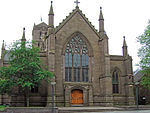City Centre, Dundee
Areas of DundeeCentral business districts in the United KingdomEngvarB from November 2017
Until the industrial revolution, the current City Centre represented the full extent of the City of Dundee, Scotland. Now roughly encircled by the market gait dual carriageway, the city centre is now the main shopping and commercial district. Unlike the city centre of Glasgow, many of the city centre's streets (especially in the southern and eastern quarters) are not built on a grid plan and in that way have more in common with the street plan of the Old Town of Edinburgh (although most buildings in Dundee's city centre date from the 19th century or later).
Excerpt from the Wikipedia article City Centre, Dundee (License: CC BY-SA 3.0, Authors).City Centre, Dundee
Nethergate, Dundee City Centre
Geographical coordinates (GPS) Address Nearby Places Show on map
Geographical coordinates (GPS)
| Latitude | Longitude |
|---|---|
| N 56.458339 ° | E -2.971933 ° |
Address
Mecca Bingo
Nethergate 104-110
DD1 4EH Dundee, City Centre
Scotland, United Kingdom
Open on Google Maps









